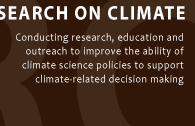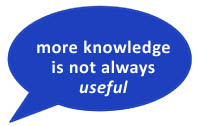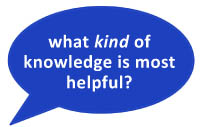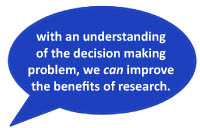

PART 3: |
|||
RECONCILING SUPPLY AND DEMAND We suggest conceptualizing the problem of managing science for decision making in terms of the relationship between the “supply” of science information, and the “demand” for usable information. The notion of supply and demand and their relationship is borrowed from economics, where supply and demand are strongly interrelated, interdependent, and co-determined. In science policy, however, explicit demand for information by potential users outside of the scientific community is rarely a strong determinant of the supply of scientific information. Ensuring that the supply of scientific information is in line with the needs of decision makers requires attentive management. There is no “invisible hand.” |
|||
CHARACTERIZING SUPPLY Awareness of the factors that steer science in one direction or another facilitates clearer thinking about research prioritization. How did some programs or particular issues come to win priority over others? Which inputs should inform one’s choice of research pathways? How might those inputs change over time? How should one balance the many important priorities espoused by an agency or program in order to produce usable science? |
 |
||
When science-policy decision makers are aware of the range of research currently under way to address a given problem, they may leverage areas of overlap, fill important gaps in existing knowledge, and generally direct agendas to where they are most needed. However, characterizing supply requires an assessment of information needs relative to a decision context, as opposed to a discipline or field. |
 |
||
Scientific research inevitably leads to more questions, expanding the possibilities for research. But the progress of knowledge within a particular scientific discipline (such as hydrology or ecology) is not necessarily linked to real-world problems (such as drought or species loss). For example, an incremental advance in the skill of a groundwater model may be of interest to hydrologists in the field; but that advance may not translate into any additional utility for water managers and others dealing with water scarcity issues. Producing science for decision making requires recognizing the differences between supporting research valued by the discipline itself, and supporting research for the purpose of solving a particular problem. Every research program will approach these trade-offs differently. When managers explicitly recognize this tension in their decisions about research funding, they are better positioned to make decisions that lead to useful knowledge. |
 |
||
|
|||
SEE A CASE FOR ORGANIZATIONAL CHANGE: NOAA AND HURRICANE RESEARCH UNDERSTANDING DEMAND A farmer making a decision about what crops to plant, and when, may benefit from a seasonal forecast. However, his ability to use and benefit from forecast information depends on his social and economic resources, his tolerance for risk, and his trust in those delivering the information, in addition to the climatological realities of the region. The forecast information needs of a subsistence farmer may differ widely from those of a large farming corporation. The demand for information is rarely represented by a single perspective. The diversity of potential users may result in a cacophony of voices, each with a unique view of decision making problems and their solutions and unique information needs. For this reason, an all-inclusive approach to working with users could be as ineffectual as ignoring user needs altogether. There is no single process or set of criteria for determining the best way to incorporate user needs into a research program. However, based on our own studies of programs that have undertaken user engagement, we identify three considerations that play a prominent role in assessing demand:
Each of these considerations depends on the others. For example, one might want to identify users who can help to define the decision-making problem before describing desired outcomes. Alternatively, identifying a manageably narrow group of users might require careful definition of the problem in advance. In practice, this will almost certainly amount to a process of continual adjustment as knowledge advances, user needs change, and understandings of the problem evolve. In addition, some elements of the process may be beyond the control of a decision maker if, for example, they are specified as part of the legislative process. Decisions regarding the approach to creating usable science depend largely on the organizational context (e.g. mission, goals) of the research program, the resources available, and the context of the research to be undertaken. SEE ORGANIZATIONAL CHANGE IN THE US GEOLOGICAL SURVEY RECONCILING SUPPLY AND DEMAND We have condensed the conceptual problem of reconciling the supply and demand of scientific information into a simple graphic called the “Missed Opportunity Matrix.” All too often, the two simple questions proffered in the matrix do not play a role in the decision making of science managers. We believe that asking these questions in the normal course of writing requests for proposals, reviewing grant proposals, and evaluating results, involves a shift in attitude that can benefit users and researchers alike. |
|||
|
|||
SEE CONGRESS AND USABLE SCIENCE In working to reconcile supply and demand, science policy decision makers must:
These are not incremental steps of a linear process; they are ongoing, complementary components of supporting research that helps people to make better decisions. Reconciling the supply and demand of scientific information requires more than a single workshop or focus group; it must be built into the institutions that make decisions about science priorities. |
|||
|
|||


